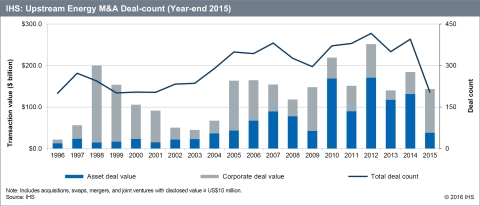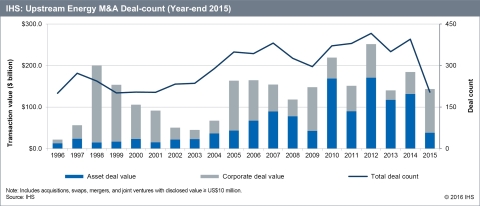HOUSTON--(BUSINESS WIRE)--Despite an ample supply of oil and gas assets on the market due to low oil prices, the overall merger and acquisition (M&A) deal count in the upstream energy sector plunged in 2015 as the weakness and volatility in oil prices made it difficult for buyers and sellers to achieve consensus on value and outlook. These findings come from new analysis by IHS Inc. (NYSE: IHS), the leading global source of critical information and insight.
Despite the boost from Shell’s $85 billion agreement to take over BG Group, total transaction value for global upstream oil and gas M&A deals in 2015 declined 22 percent to $143 billion from $184 billion in 2014, when transaction value rose 30 percent year-over-year. In 2015, several large, unsolicited corporate takeover bids were rejected and asset deal value fell to a 10-year low.
“Unstable oil prices caused outlook uncertainty in 2015, and this lack of stability, a key ingredient for buyers and sellers to reach consensus, caused fewer deals to be reached,” said Christopher Sheehan, director of energy M&A research at IHS, and lead author of the IHS Energy Global Upstream M & A Review. “There continues to be a wide disconnect between potential acquirers and sellers regarding valuations of the huge supply of assets on the market that vary in quality. At the same time, corporate takeover targets that suffered severe share price declines are reluctant to sell at modest current premiums in a weak market.”
“During 2015, traditional funding avenues remained generally available for E&Ps, lessening the pressure to consolidate,” Sheehan said. “However, we believe the likelihood for wider consolidation in the oil and gas industry will increase in 2016 as producers face further financial pain and will have more constrained financing options due to persistently weak oil prices.”
The softness in deal activity during the final two months of 2014 carried over into early 2015, the IHS report noted, and while oil prices and deal flow briefly rebounded in the spring, volatile and declining crude prices during the remainder of 2015 kept many potential buyers and sellers on the sidelines.
According to IHS Energy M&A research, worldwide deal count (which includes both asset deals and corporate deals) fell by nearly 50 percent in 2015 to the lowest level since 2001. Asset deals represented 80 percent of total deals, but the number of both worldwide asset and corporate transactions fell steeply. Corporate deal count plunged to a 20-year low, IHS noted.
A significant development in 2015 was the emergence of more than $60 billion in unsolicited corporate takeover bids by larger, financially-stable companies that targeted more distressed peers. The rejection of these bids, compounded by low asset-deal value, dampened total transaction value. Other than Shell’s agreement to acquire BG, there were no corporate takeovers exceeding $5 billion. In 2015, there were fewer than 10 asset deals valued at greater than $1 billion, following more than 30 annually during each of the previous two years.
For the second consecutive year, Asian national oil companies (NOCs) reined in overseas acquisition spending, and their global market share for upstream oil and gas acquisitions in 2015 declined to the lowest level since 2007. Chinese NOCs, continuing to undergo internal restructuring, spent less than $5 billion on acquisitions for the second straight year. Meanwhile, financial buyers, led by private equity firms, spent more than $25 billion investing in acquisitions, joint ventures, and funding private exploration and production (E&P) companies.
Global spending on unconventional assets plunged to less than $30 billion in 2015 after topping more than $75 billion in 2014, causing its market share of total worldwide upstream deal value to decline from 40 percent to 20 percent in 2015. North America continued to be the dominant target for transactions of unconventional resources, led by deals in the U.S.
North America Accounted for 60 Percent of Worldwide Deal Value for 2015
IHS found that North America, excluding the weighting of the globally-diversified Shell/BG deal, accounted for approximately 60 percent of worldwide upstream deal value for the second consecutive year. Canada’s market share fell slightly from 13 percent to 11 percent, with only one deal exceeding $1 billion. Oil sands deal activity continued to be relatively dormant for the third straight year. Excluding Shell’s agreement to purchase BG Group, the United States represented 50 percent of global upstream oil and gas transaction value in 2015, similar to its share in 2014. The U.S. accounted for slightly more than half the number of total worldwide deals, above its historical average. However, only three of the top 10 largest transactions in 2015 were in the U.S., versus five the prior year.
Total U.S. transaction value declined by 60 percent—from almost $90 billion in 2014—to $35 billion in 2015. For the second consecutive year, four of the top five largest U.S. deals targeted unconventional resources, led by Noble Energy’s $3.8 billion acquisition of Rosetta Resources. However, U.S. corporate transaction value fell by more than 55 percent and U.S. asset deal value declined by 70 percent to the lowest total since 2009.
“The continued weakness in commodity prices is having a dramatic impact on valuations in the asset transaction market,” Sheehan said. “Deal pricing for U.S. oil and liquids proved reserve assets fell extremely sharply in 2015. U.S. gas asset deal pricing also declined steeply. Asset deal market pricing in the U.S. for both commodities plummeted to 10-year lows.”
Largest Global Deals in 2015 Were Focused Outside North America
Transactions outside North America dominated the top 10 largest global deals in 2015, after accounting for slightly less than half of the top 10 deals in 2014. The largest transactions featured globally-diversified deal activity in the Russia and Caspian, Asia-Pacific, Africa and Middle East and Europe. When including the Shell/BG deal, North America accounted for only 30 percent of global deal value.
“Our IHS analysis of upstream companies indicates that oil and gas producers with heavy debt burdens and hedges rolling off in 2016 will become increasingly vulnerable,” Sheehan said. “They will either have to dispose of prized assets, face serious restructuring -- including the potential for bankruptcy -- or become takeover targets in 2016,” Sheehan said. “The volume of global assets for sale and companies under financial duress are surging as oil prices continue to be subdued. Our IHS Energy Significant Energy Assets on the Market (SEAM) database is tracking more than $200 billion of oil and gas property and corporate opportunities that have the potential to transform the portfolios of stronger players.”
For more information on subscribing to the IHS Energy M&A Research or the IHS SEAM Database, please contact leslie.downey@ihs.com. To speak with Christopher Sheehan, please contact melissa.manning@ihs.com or press@ihs.com.
About IHS (www.ihs.com)
IHS (NYSE: IHS) is the leading source of insight, analytics and expertise in critical areas that shape today’s business landscape. Businesses and governments in more than 140 countries around the globe rely on the comprehensive content, expert independent analysis and flexible delivery methods of IHS to make high-impact decisions and develop strategies with speed and confidence. IHS has been in business since 1959 and became a publicly traded company on the New York Stock Exchange in 2005. Headquartered in Englewood, Colorado, USA, IHS is committed to sustainable, profitable growth and employs approximately 8,600 people in 32 countries around the world.
IHS is a registered trademark of IHS Inc. All other company and product names may be trademarks of their respective owners. © 2016 IHS Inc. All rights reserved.
If you prefer not to receive news releases from IHS, please email melissa.manning@ihs.com. To read our privacy policy, click here.




